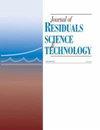Effects of Chlorine and Phosphor on Zinc Transformation Behavior During SewageSludge Combustion
引用次数: 0
Abstract
Effects of chlorine and phosphor on the transformation of zinc during combustion of sewage sludge (SS) was investigated by two approaches: combustion experiment and thermodynamic simulation. The result of thermodynamic simulation predicted that zinc existed as ZnSO4 (s) below 400°C, while mainly as phosphate in solid phase when the combustion temperature was in the range from 500–1200°C but was released as metallic vapor at higher temperatures (>1300°C). NaZnPO4 and Zn(PO3)2 were experimentally detected by X-ray diffraction in sewage sludge slag (SSA) at 900°C. The volatilization rate of zinc was below 10.00% in all cases, and increased slowly along with the combustion time and temperature. However, this volatilization rate significantly increased with chlorine addition through the formation of metal chloride, while phosphor additives restrained the volatilization of zinc.氯和磷对污泥燃烧过程中锌转化行为的影响
采用燃烧实验和热力学模拟两种方法研究了氯和荧光粉对污泥燃烧过程中锌转化的影响。热力学模拟结果表明,在400℃以下,锌以ZnSO4 (s)的形式存在;在500 ~ 1200℃的燃烧温度范围内,锌主要以磷酸盐的形式存在于固相中;在高于1300℃的温度下,锌以金属蒸汽的形式释放。采用x射线衍射法在900℃下对污泥渣(SSA)中的NaZnPO4和Zn(PO3)2进行了检测。锌的挥发率均在10.00%以下,随燃烧时间和温度的增加而缓慢增加。然而,随着氯的加入,通过形成金属氯化物,这一挥发速率显著增加,而荧光粉添加剂则抑制了锌的挥发。
本文章由计算机程序翻译,如有差异,请以英文原文为准。
求助全文
约1分钟内获得全文
求助全文
来源期刊

Journal of Residuals Science & Technology
环境科学-工程:环境
自引率
0.00%
发文量
0
审稿时长
>36 weeks
期刊介绍:
The international Journal of Residuals Science & Technology (JRST) is a blind-refereed quarterly devoted to conscientious analysis and commentary regarding significant environmental sciences-oriented research and technical management of residuals in the environment. The journal provides a forum for scientific investigations addressing contamination within environmental media of air, water, soil, and biota and also offers studies exploring source, fate, transport, and ecological effects of environmental contamination.
 求助内容:
求助内容: 应助结果提醒方式:
应助结果提醒方式:


